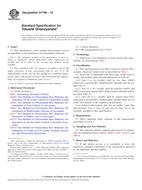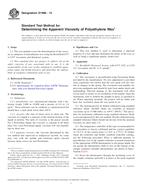Potrebujeme váš súhlas na využitie jednotlivých dát, aby sa vám okrem iného mohli ukazovať informácie týkajúce sa vašich záujmov. Súhlas udelíte kliknutím na tlačidlo „OK“.
ASTM D3364-99(2011)
Standard Test Method for Flow Rates for Poly(Vinyl Chloride) with Molecular Structural Implications
Automaticky preložený názov:
Štandardná skúšobná metóda pre prietoky pre poly (vinylchloridu) s molekulárnou štrukturálne dôsledky
NORMA vydaná dňa 1.9.2011
Informácie o norme:
Označenie normy: ASTM D3364-99(2011)
Poznámka: NEPLATNÁ
Dátum vydania normy: 1.9.2011
Kód tovaru: NS-23429
Počet strán: 5
Približná hmotnosť: 15 g (0.03 libier)
Krajina: Americká technická norma
Kategória: Technické normy ASTM
Kategórie - podobné normy:
Anotácia textu normy ASTM D3364-99(2011) :
Keywords:
chain shearing, crosslinking, degradation, fragmentation, melt flow rate, poly(vinyl chloride), rheology, shear instability: Crosslinking, Degradation--plastics, Flow and flow rate--thermoplastics, Melt flow rate (of thermoplastics), Poly(vinyl chloride)(PVC), Shear instability, ICS Number Code 83.080.20 (Thermoplastic materials)
Doplňujúce informácie
| Significance and Use | ||||||||||
|
This test method is useful for quality-control tests on PVC compounds having a wide range of melt viscosities. Measurements are made at shear rates close to 1 s−1. In addition to the properties mentioned in Test Method D1238, this technique is sensitive to plasticizer content, polymer molecular weight, polymer stability (both thermally and rheologically), shear instability, and general composition. The sensitivity of the material to temperature necessitates slightly tighter controls than those stated in Test Method D1238. The sensitivity of this test method makes it useful for correlating with processing conditions and as an aid in predicting changes in processing. However, as a one-point measure of flow relative to shear rate, its one drawback is that the same PVC melt flow values can be obtained for materials having different processibility; the chance of this happening is minimized, however, if the compounds are similar in composition. Correlations with a wide range of processing conditions have supported the conclusions that little or no change in composition occurs during the test. Thus, this test is able to detect and follow profound changes which occur during extrusion, injection molding, milling, or mixing. These changes are due to three types of measured instability in polymers: Thermal instability due to temperature effect. Shear instability due to breaking of polymer bonds. Rheological instability due to nonuniform distributions of widely different viscosity or molecular weight elements. Thus, implications with respect to PVC molecular structural changes can be detected and predicted. |
||||||||||
| 1. Scope | ||||||||||
|
1.1 This test method is an extension of Test Method D1238 specific to the measurement of flow rates of poly(vinyl chloride) (PVC) compounds while detecting and controlling various polymer instabilities associated with the flow rate. 1.2 The values stated in SI units are to be regarded as standard. The values given in parentheses are mathematical conversions to inch-pound units that are provided for information only and are not considered standard. 1.3 This standard does not purport to address all of the safety concerns, if any, associated with its use. It is the responsibility of the user of this standard to establish appropriate safety and health practices and determine the applicability of regulatory limitations prior to use. Note 1—There is no known ISO equivalent to this standard. |
||||||||||
| 2. Referenced Documents | ||||||||||
|
Podobné normy:
Historická
1.3.2008
Historická
1.4.2011
Historická
1.8.2012
Historická
1.4.2013
Historická
15.1.2010
Historická
1.10.2013
Odporúčame:
Aktualizácia technických noriem
Chcete mať istotu, že používate len platné technické normy?
Ponúkame Vám riešenie, ktoré Vám zaistí mesačný prehľad o aktuálnosti noriem, ktoré používate.
Chcete vedieť viac informácií ? Pozrite sa na túto stránku.



 ASTM D1243-95(2008)..
ASTM D1243-95(2008).. ASTM D1430-11
ASTM D1430-11 ASTM D1601-12
ASTM D1601-12 ASTM D1693-13
ASTM D1693-13 ASTM D1786-10
ASTM D1786-10 ASTM D1986-13
ASTM D1986-13
 Cookies
Cookies
